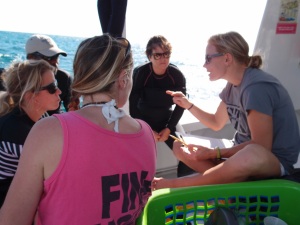by Eddy Raphael
‘Operation Forest’ is under way with the first two weeks now successfully completed. In the first week, Nassau partners Stuart Cove’s Dive Bahamas, and BREEF [Bahamas Reef Environment Educational Foundation] joined forces with The Nature Conservancy’s Northern Caribbean Program to help construct, install, and populate thirty-one new Acropora cervicornis coral propagation units [CPU’s] into the New Providence nursery at the James Bond Wreck dive site, on the south side of New Providence.
In November 2012, nine CPU’s were installed with only 3 of them being populated with Acropora cervicornis coral fragments, to assess the health, growth, and survivorship of the corals at this site before expanding the nursery. These ‘tree’ shaped CPU’s were installed in a depth of 35ft, on a sand patch between two perpendicular shipwrecks.
These types of CPUs are constructed using PVC and monofilament, and are typically placed in areas which have the least localized threats to corals as possible, which can include fisheries, human development [industry, settlement, tourism, and transportation], changes in native species dynamics [competitors, predators, pathogens and parasites], invasive species [competitors, predators, pathogens and parasites], dynamite fishing, chemical fishing, pollution from agriculture and industry, domestic pollution, sedimentation, and human recreation and tourism activities.
On Dec. 2nd 2013, the dive team, made up of The Nature Conservancy’s Scientific Divers and volunteers, Stuart Cove’s instructors, and divers from BREEF, set out from Stuart Cove’s dock with all the tools necessary to achieve their tasks. The first task was to document and measure each coral in the existing nursery.

Eddy Raphael, (TNC), Coral Conservation Coordinator, collecting data and recording growth. Photo Credit: Mallory Raphael
In just one year, coral growth has exceeded expectations. Our first look at the data has indicated that our original fragments which started as 50mm fragments now had up to 1000mm of growth, much faster than the amount normally expected from wild corals! These A. cervicornis 1-year-olds are to be fragmented into smaller pieces to populate the thirty one new CPU’s planned.

Diver hammering anchor for CPU. Left to right: Allanah Vellacott, Mallory Raphael. Photo Credit: Eddy Raphael
The task of securing the CPU’s to the seabed was next. The addition of eleven new CPU’s on the existing site, plus twenty more on a nearby site was on schedule. Special tree anchors normally used in a terrestrial setting were driven 3ft into the sand with 5lb mallets. The CPU’s would then be affixed to these anchors. A buoy at the top of the CPU is used to keep the ‘tree’ floating upright, the branches are placed perpendicularly to one another so the corals have room to hang, grow, and sway in the current.
The Conservancy’s own American Academy of Underwater Science [AAUS] Scientific Divers were assigned to fragment the corals. 50 coral fragments were placed in a bag and given to each diver, to safeguard the polyps during transfer to the nursery. The tiny fragments were then transported to the CPU’s, and secured in monofilament nooses in a hanging position. A numbering system for the CPUs was then carried out and the nursery mapped.
The next phase in January 2014 is to add another sixty trees, in rows of twenty, alongside the newly installed nursery on the adjacent sand flats. Stay tuned for updates!
To learn how to become a volunteer diver with The Nature Conservancy leave a comment or send us a message on Facebook.


Magnificent goods from you, man. I’ve understand your stuff previous to and you are just too wonderful.
I really like what you have acquired here, certainly like what you are
stating and the way in which you say it. You make it enjoyable and you still care
for to keep it smart. I can’t wait to read much more
from you. This is really a wonderful website.
Pingback: Andros Conservancy and Trust and The Nature Conservancy | The Nature Conservancy's Northern Caribbean Program
Incredible work and fantastic results! It’s great to see a project such as this being met with this kind of success.
I’m a PADI Divemaster, but most importantly a lover of reef ecosystems. I spent the last 6 months in Thailand working as a conservationist and experimenting with different artificial reef methods with the New Heaven Reef Conservation Program’s director Chad Scott.
I’m currently trying to find a placement as a Divemaster down on Nassau, and if I’m fortunate enough to do so I’d love to be involved with ‘Operation Forest’. It’s been 8 months since this article was written and I’m curious to hear how the project has developed thus far. Have the 60 artificial trees that were planned already been put into place? Also, how and when will you transplant the corals grown on the CPU nurseries to a permanent reef location?